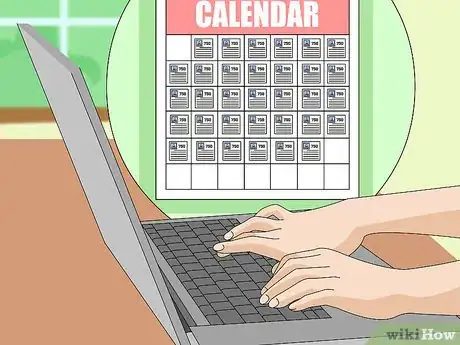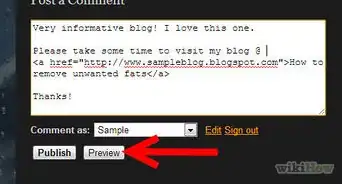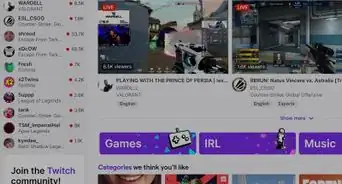This article was co-authored by Peter Fryer. Peter Fryer is a tennis writer and coach based in Derry Northern Ireland. He completed his professional teaching tennis qualification shortly after finishing university and has been teaching tennis for over 13 years. Peter began Love Tennis Blog in 2010 and contributes to the BBC and national media outlets.
There are 11 references cited in this article, which can be found at the bottom of the page.
wikiHow marks an article as reader-approved once it receives enough positive feedback. In this case, 100% of readers who voted found the article helpful, earning it our reader-approved status.
This article has been viewed 75,983 times.
Blogging, a portmanteau of web logging, has been around since the 1990s.[1] Blogs can cover any number of personal interests, including travel, culinary guides, and sports. Sports blogs allow fans of a given sport to share sporting news and opinions on sports-related topics, and could help lead to a career in sports journalism or game analysis. There are a lot of options in how to design and implement a sports blog, and it may seem overwhelming if you're new to blogging. Knowing how to start your own blog can give you an outlet for your opinions on your favorite sports teams and allow you to connect with other sports fans.
Steps
Choosing a Blogging Platform
-
1Decide how you want your blog to look. It's important to decide how you want your blog to appear, because in part this will determine how your blog is consumed. You might want a more visually-oriented blog, posting screenshots of scoreboards or photos from a game, for example. Or you might want a blog that lets you write long, detailed reports on game statistics, player performance, or predictions for the season. How you envision your blog appearing and being used may affect your choice of platform.[2]
- A primarily visual blog can be built for free using a site like Tumblr. Tumblr is widely used as a form of social media across all demographics, has mobile compatibility, and uses tags that can help drive traffic to your blog.[3]
- A platform like Medium might be more compatible to a longer, text-driven blog.[4]
- Platforms like Typepad and WordPress can be curated to either a visual or text-driven blog.[5]
- Look at other websites and try to understand what it is that you like about them. You can then pick out some features that you could use in your blog.
-
2Choose between free or paid services. It may seem like an obvious choice, and for cash-strapped bloggers it may be a necessity to choose a free service. But the trade-off is that a paid service, which typically charges a monthly fee of $8.00 or more, allows you total control over the design and layout of your blog, and may offer technical support and search-engine optimization for your blog.[6] There's no clear-cut answer to this choice, but some factors to consider as you choose between free or paid services include:
- how important design and layout are to you
- how often you will write for your blog
- how big an audience you hope to reach
Advertisement -
3Determine if you want ownership. This is another choice that may seem obvious, but owning your site outright (called a self-hosted blog) or using an existing blogging platform both have their advantages and disadvantages. Owning your own self-hosted blog requires you to pay for a registered domain name, which can cost anywhere from $7 to $15 annually.[7]
- The advantage to a self-hosted blog is that you have full ownership of your site's content, and you can sell ads on your blog and make money.[8]
- The downside to a self-hosted blog is that it requires maintenance and some extra time and effort. You'll need to update the software for your blog's platform when new updates are released, whereas if you were using an existing blog platform the site would be automatically updated by the platform's server.[9]
- If you're just getting started in blogging and aren't sure whether it's something you'll want to continue long term, you may want to opt for a free platform on an existing server that won't require you to do anything other than post updates from time to time. Remember that usually sport blogs start small, but they can grow exponentially in a few months by producing quality unique content and being interesting to the readers.
Getting Your Blog Started
-
1Follow a sport or team closely. If you're blogging about sports, you have some flexibility in terms of subject matter. You may want to write about the sport itself, covering an entire league or even multiple leagues. You may want to focus on a sport's conference, an individual team, all the teams in a given city, or even an individual player. Unless you're extremely knowledgeable about a sport and follow the entire league's play closely, it may be easiest to focus on an individual team or player (especially if this is your first blog).[13]
-
2Find some kind of niche. Once you've been following a team or teams to report on long enough to get some material, you'll want to find some kind of niche within sports blogging. There are countless sports blogs on the internet, and many of them are written by knowledgeable, passionate sports fans. So what will set your blog apart from the rest and make people want to follow your posts? Some bloggers focus on subjects that sports fans are interested in across all teams and regions, such as collective bargaining agreements or other financial aspects of sports. Whatever niche you choose, it's important to find a subject that you have some kind of special knowledge or authority on, as this will help establish your blog much more quickly.
- Think about whether any aspect of your education, work experience, or life experience qualifies you to become an expert on a certain area of sports reportage. This can help you find your focus and may help you gain popularity more quickly.
-
3Customize your blog as much as possible. Depending on the platform you've chosen, you may have limitations with regards to how much you can customize your blog. But it's a good idea to make your page as unique as possible. Creating a logo, customizing the layout of your blog page, and adding colorful photos help set your blog apart from other sports blogs on the internet, which is important in getting your page off the ground.[14] Having a meticulously-customized blog page might also help inspire you to be more active in writing posts and maintaining the page.
- Try looking at some successful sports blogs for inspiration and ideas about what kind of customization is possible. You can even search for "sports blog design" in an online search engine to find some striking and successful examples.[15]
Writing Successful Blog Posts
-
1Consider your audience. One of the most important things to remember when undertaking any kind of writing project is to consider who your audience is, and what they want from you as the blog writer. Your audience is obviously an audience of sports fans, but within that demographic, who are you trying to reach? Former athletes who are now sports fans? Parents of athletes? It may be worth deciding who you want to inform and entertain before writing your blog, so that you know how to tailor your posts to meet the needs and interests of that audience.[16]
-
2Keep your posts short. Most readers checking in on a sports blog won't want to commit to spending an hour on a sports manifesto. Keep it short, but punchy. Some experts recommend a maximum of 750 words per post in order to ensure that you don't lose a reader's attention.
-
3Give it personality. No two blogs are going to be exactly the same. The best and most sincere way to make your blog stand out is to let your personality come through in your writing and invest a piece of yourself into the blog. Readers will enjoy your blog for the same reason your friends enjoy spending time with you - because reading your blog feels like having a conversation with you.[17]
-
4Take a stance. Some of the best-ranked sports blogs are those that make an argument and defend that position. Some experts believe the reason for these sites' popularity is because news outlets already report objectively on players, teams, and league happenings. Sports fans can find that information anywhere, but a writer who takes a stance and argues for or against a subjective opinion is not something you'll see as much on ESPN.[18]
-
5Show readers something the news won't. Much like taking a stance on an issue, another thing sports fans seek out in popular blogs is the under-reported dirty laundry of sports. Many people feel tantalized by a good scandal, and sports blogs that address athlete drug use or otherwise bad behavior, for example, give fans something to gossip about.[19]
- For an excellent example of a sports blog that addresses the dirty laundry of sports stars, take a look at badjocks.com. It's grouped into topics like illegal activity, dumb behavior, and painful injuries.
-
6Pick a good title. Each blog post needs a title, and how you phrase that title is important, as it could make or break someone's interest. If you can get a reader to read the first few lines, that reader will probably be interested.[20] The title is how you pull people in. When choosing a title for a given blog post, consider:
-
7Make your posts SEO-friendly. One of your goals as a blogger should be to reach as wide an audience as possible. You can do this by making your blog posts SEO-friendly. SEO, or search engine optimization, is the use of key words that will bring your posts closer to the top of an online search in a search engine like Google.[25]
- Use key words early on in the title to ensure that your post shows up earlier in search results. So, for example, instead of titling your post "Ten Ways to Write a Great Sports Blog," try titling the post "Writing a Great Sports Blog: Ten Great Strategies".[26]
Running a Successful Blog
-
1Aim for longevity. Don't say everything you have to say on your subject in the first few blog posts. You'll be left scratching your head wondering what more there is to say on your blog. Instead, try to think in terms of longevity: will these issues change over time? Will they be relevant in six months? Rather than saying everything in one long-winded blog post, ask yourself how you can break that idea up into many smaller (750 or fewer words) blog posts that can be posted serially for several weeks. It takes a while to gain a dedicated readership, so you don't want to run out of steam once fans finally start to take an interest in your blog.[27]
-
2Make posts often. The best thing you can do for your blog is to make frequent posts. Whether you commit to a daily blog post, weekly posts, or somewhere in between, keeping your blog's feed fresh will help keep people coming back to your blog. Anyone who is interested in what you're saying will want to check back regularly to read your newest posts, which is crucial to getting your blog noticed.[28]
-
3Respond to comments. One thing that will keep readers coming back is if they feel like their voices are being heard. Let readers comment on your blog posts, and respond to as many as you can, both good comments and critical ones. This allows readers to feel like there's a dialogue, and readers may even suggest compelling topics they'd like to see in future blog posts.[29]
-
4Encourage readers to subscribe. Some blog platforms allow readers to subscribe to a blog's RSS (rich site summary) feed. Readers who subscribe to your RSS feed can view your blog posts through an RSS feed reader without having to track down your blog page to check for updates and new posts.
- To gently remind readers to subscribe, you can use a standard line at the end of your blog posts, like "If you enjoyed what you've read, please consider subscribing to my RSS feed for all the latest news in sports."
-
5Make posts on weekdays. Online analysis suggests that blog posts tend to receive more web traffic when they're posted on weekdays instead of weekends. That's because many people kill time online at work, whereas weekends tend to be reserved for vacations, running errands, or spending time with family members.
-
6Use social media. If you're serious about blogging and want it to lead to a job as a writer or sports analyst, you'll want to promote your blog on social media sites. You can do this through your own personal social media account, or create an account for your blog and invite your friends to follow you on your chosen social media site. This will help your blog get attention and a broader base of readers, and can help your readers/followers keep on top of the newest blog updates. Social media also lets you interact with your readers, answer questions, and take suggestions for future blog posts.[30]
-
7Make connections. Whether you focus on promoting your blog through social media or by word of mouth, it's important to make connections. You can reach out to players, teams, or even brands and companies that you frequently blog about. They might be willing to participate in an interview, or at least re-post a social media update about a particular blog post you've written. You can also reach out to other bloggers and collaborate on future projects, or invite one another to write a guest post on each other's blog page.[31] Building connections with other bloggers and relevant subjects can help you build a community online and get some additional web traffic for your blog.[32]
Expert Q&A
-
QuestionHow do you write a good sports blog?
 Peter FryerPeter Fryer is a tennis writer and coach based in Derry Northern Ireland. He completed his professional teaching tennis qualification shortly after finishing university and has been teaching tennis for over 13 years. Peter began Love Tennis Blog in 2010 and contributes to the BBC and national media outlets.
Peter FryerPeter Fryer is a tennis writer and coach based in Derry Northern Ireland. He completed his professional teaching tennis qualification shortly after finishing university and has been teaching tennis for over 13 years. Peter began Love Tennis Blog in 2010 and contributes to the BBC and national media outlets.
Tennis Instructor Know your stuff! Read and watch as much of the sport as you can, learn the inner workings of it, and become an expert in your field. It also helps to connect with other sports fanatics and share your knowledge, time, and advice.
Know your stuff! Read and watch as much of the sport as you can, learn the inner workings of it, and become an expert in your field. It also helps to connect with other sports fanatics and share your knowledge, time, and advice.
Warnings
- Beware of rivals that might start spamming your page!⧼thumbs_response⧽
References
- ↑ http://www.digitaltrends.com/web/how-to-start-a-blog/
- ↑ http://www.nytimes.com/2014/07/24/technology/personaltech/where-to-start-when-starting-a-blog.html?_r=0
- ↑ http://www.nytimes.com/2014/07/24/technology/personaltech/where-to-start-when-starting-a-blog.html?_r=0
- ↑ http://www.nytimes.com/2014/07/24/technology/personaltech/where-to-start-when-starting-a-blog.html?_r=0
- ↑ http://www.nytimes.com/2014/07/24/technology/personaltech/where-to-start-when-starting-a-blog.html?_r=0
- ↑ http://www.nytimes.com/2014/07/24/technology/personaltech/where-to-start-when-starting-a-blog.html?_r=0
- ↑ http://blogging.org/blog/how-much-does-it-cost-to-start-a-blog/
- ↑ http://blogging.org/blog/self-hosted-wordpress-org-vs-free-wordpress-com-which-is-better/
- ↑ http://blogging.org/blog/self-hosted-wordpress-org-vs-free-wordpress-com-which-is-better/
- ↑ http://blogging.org/blog/self-hosted-wordpress-org-vs-free-wordpress-com-which-is-better/
- ↑ http://blogging.org/blog/self-hosted-wordpress-org-vs-free-wordpress-com-which-is-better/
- ↑ http://blogging.org/blog/self-hosted-wordpress-org-vs-free-wordpress-com-which-is-better/
- ↑ http://blogging.org/blog/how-to-start-a-sports-blog/
- ↑ http://blogging.org/blog/how-to-start-a-sports-blog/
- ↑ http://blogging.org/blog/how-to-start-a-sports-blog/
- ↑ http://www.entrepreneur.com/article/232489
- ↑ http://journalism.nyu.edu/publishing/archives/notablog/story/good_blog/
- ↑ http://www.forbes.com/2003/09/29/cx_dd_0929sportsblogs.html
- ↑ http://www.forbes.com/2003/09/29/cx_dd_0929sportsblogs.html
- ↑ http://www.problogger.net/archives/2008/08/20/how-to-craft-post-titles-that-draw-readers-into-your-blog/
- ↑ http://www.problogger.net/archives/2008/08/20/how-to-craft-post-titles-that-draw-readers-into-your-blog/
- ↑ http://www.problogger.net/archives/2008/08/20/how-to-craft-post-titles-that-draw-readers-into-your-blog/
- ↑ http://www.problogger.net/archives/2008/08/20/how-to-craft-post-titles-that-draw-readers-into-your-blog/
- ↑ http://www.problogger.net/archives/2008/08/20/how-to-craft-post-titles-that-draw-readers-into-your-blog/
- ↑ http://www.forbes.com/sites/jacquelynsmith/2012/08/06/how-to-make-your-blog-get-real-attention-2/
- ↑ http://www.forbes.com/sites/jacquelynsmith/2012/08/06/how-to-make-your-blog-get-real-attention-2/
- ↑ http://www.entrepreneur.com/article/232489
- ↑ http://blogging.org/blog/how-to-start-a-sports-blog/
- ↑ http://www.forbes.com/sites/jacquelynsmith/2012/08/06/how-to-make-your-blog-get-real-attention-2/
- ↑ http://www.pcadvisor.co.uk/how-to/internet/how-start-blog-3572640/
- ↑ http://www.pcadvisor.co.uk/how-to/internet/how-start-blog-3572640/
- ↑ http://www.pcadvisor.co.uk/how-to/internet/how-start-blog-3572640/
About This Article
To start a sports blog, first choose a platform for publishing your posts, such as Tumblr if you want a visual blog or Wordpress if you want a text-driven blog. If you’re really committed, you might even decide to buy your own domain name, which usually costs between $7-$15 each year and allows you to earn money with paid ads. Then, think about what you want to blog about, whether that be a specific sport, a league, or even a specific player. Try to find a unique angle, as this will make your blog interesting and set you apart from the rest! To learn how to get readers to subscribe to your blog, read on!


















































































